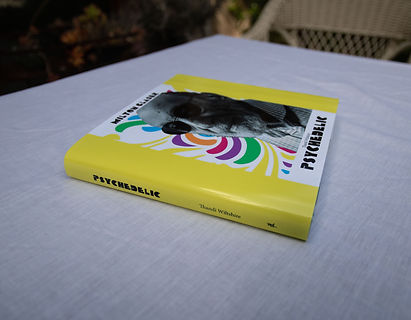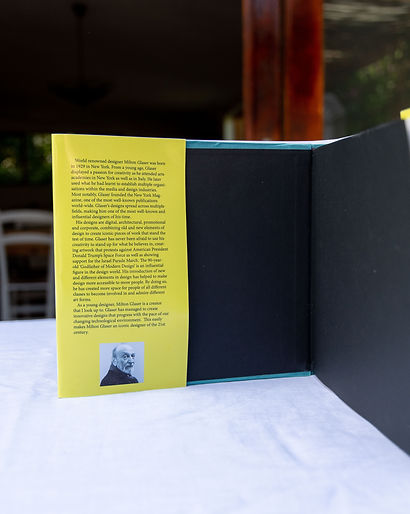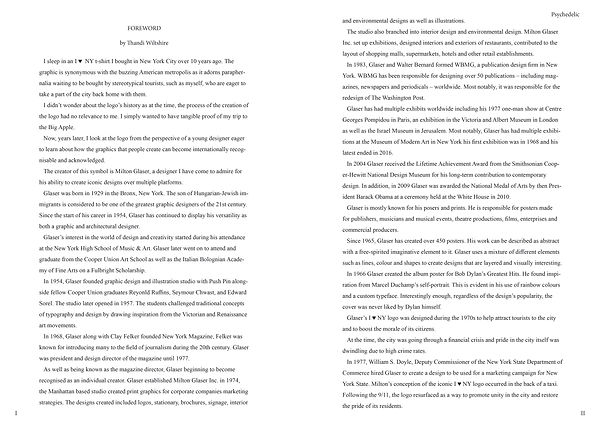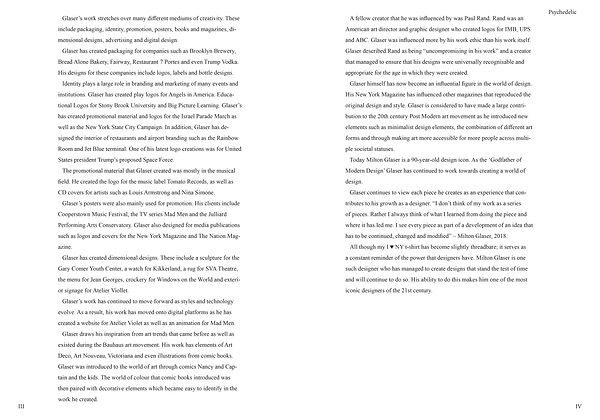BOOK COVER & ESSAY
milton glaser
I sleep in an I NY t-shirt I bought in New York City over 10 years ago. The graphic is synonymous with the buzzing American metropolis as it adorns paraphernalia waiting to be bought by stereotypical tourists, such as myself, who are eager to take a part of the city back home with them.
I didn’t wonder about the logo’s history as at the time, the process of the creation of the logo had no relevance to me. I simply wanted to have tangible proof of my trip to the Big Apple.
Now, years later, I look at the logo from the perspective of a young designer eager to learn about how the graphics that people create can become internationally recognisable and acknowledged.
The creator of this symbol is Milton Glaser, a designer I have come to admire for his ability to create iconic designs over multiple platforms.
Glaser was born in 1929 in the Bronx, New York. The son of Hungarian-Jewish immigrants is considered to be one of the greatest graphic designers of the 21st century. Since the start of his career in 1954, Glaser has continued to display his versatility as both a graphic and architectural designer.
Glaser’s interest in the world of design and creativity started during his attendance at the New York High School of Music & Art. Glaser later went on to attend and graduate from the Cooper Union Art School as well as the Italian Bolognian Academy of Fine Arts on a Fulbright Scholarship.
In 1954, Glaser founded graphic design and illustration studio with Push Pin alongside fellow Cooper Union graduates Reyonld Ruffins, Seymour Chwast, and Edward Sorel. The studio later opened in 1957. The students challenged traditional concepts of typography and design by drawing inspiration from the Victorian and Renaissance art movements.
In 1968, Glaser along with Clay Felker founded New York Magazine, Felker was known for introducing many to the field of journalism during the 20th century. Glaser was president and design director of the magazine until 1977.
Milton Glaser dust jacket, click to view
As well as being known as the magazine director, Glaser beginning to become recognised as an individual creator. Glaser established Milton Glaser Inc in 1974, the Manhattan based studio created print graphics for corporate companies marketing strategies. The designs created included logos, stationary, brochures, signage, interior and environmental designs as well as illustrations.
The studio also branched into interior design and environmental design. Milton Glaser Inc set up exhibitions, designed interiors and exteriors of restaurants, contributed to the layout of shopping malls, supermarkets, hotels and other retail establishments.
In 1983, Glaser and Walter Bernard formed WBMG, a publication design firm in New York. WBMG has been responsible for designing over 50 publications – including magazines, newspapers and periodicals – worldwide. Most notably, it was responsible for the redesign of The Washington Post.
Glaser has had multiple exhibits worldwide including his 1977 one-man show at Centre Georges Pompidou in Paris, an exhibition in the Victoria and Albert Museum in London as well as the Israel Museum in Jerusalem. Most notably, Glaser has had multiple exhibitions at the Museum of Modern Art in New York his first exhibition was in 1968 and his latest ended in 2016.
In 2004 Glaser received the Lifetime Achievement Award from the Smithsonian Cooper-Hewitt National Design Museum for his long-term contribution to contemporary design. In addition, in 2009 Glaser was awarded the National Medal of Arts by then President Barack Obama at a ceremony held at the White House in 2010.
Glaser is mostly known for his posers and prints. He is responsible for posters made for publishers, musicians and musical events, theatre productions, films, enterprises and commercial producers.
Since 1965, Glaser has created over 450 posters. His work can be described as abstract with a free-spirited imaginative element to it. Glaser uses a mixture of different elements such as lines, colour and shapes to create designs that are layered and visually interesting.
In 1966 Glaser created the album poster for Bob Dylan’s Greatest Hits. He found inspiration from Marcel Duchamp’s self-portrait. This is evident in his use of rainbow colours and a custom typeface. Interestingly enough, regardless of the design’s popularity, the cover was never liked by Dylan himself.
Glaser’s I NY logo was designed during the 1970s to help attract tourists to the city and to boost the morale of its citizens.
At the time, the city was going through a financial crisis and pride in the city itself was dwindling due to high crime rates.
In 1977, William S. Doyle, Deputy Commissioner of the New York State Department of Commerce hired Glaser to create a design to be used for a marketing campaign for New York State.
Milton’s conception of the iconic I NY logo occurred in the back of a taxi. Following the 9/11, the logo resurfaced as a way to promote unity in the city and restore the pride of its residents.
Glaser’s work stretches over many different mediums of creativity. These include packaging, identity, promotion, posters, books and magazines, dimensional designs, advertising and digital design.
Glaser has created packaging for companies such as Brooklyn Brewery, Bread Alone Bakery, Fairway, Restaurant 7 Portes and even Trump Vodka. His designs for these companies include logos, labels and bottle designs.
Identity plays a large role in branding and marketing of many events and institutions. Glaser has created play logos for Angels in America. Educational Logos for Stony Brook University and Big Picture Learning.
Glaser’s has created promotional material and logos for the Israel Parade March as well as the New York State City Campaign. In addition, Glaser has designed the interior of restaurants and airport branding such as the Rainbow Room and Jet Blue terminal. One of his latest logo creations was for United States president Trump’s proposed Space Force.
The promotional material that Glaser created was mostly in the musical field. He created the logo for the music label Tomato Records, as well as CD covers for artists such as Louis Armstrong and Nina Simone.
Glaser’s posters were also mainly used for promotion. His clients include Cooperstown Music Festival, the TV series Mad Men and the Julliard Performing Arts Conservatory. Glaser also designed for media publications such as logos and covers for the New York Magazine and The Nation Magazine.
Glaser has created dimensional designs. These include a sculpture for the Gary Comer Youth Center, a watch for Kikkerland, a rug for SVA Theatre, the menu for Jean Georges, crockery for Windows on the World and exterior signage for Atelier Viollet.
Glaser’s work has continued to move forward as styles and technology evolve. As a result, his work has moved onto digital platforms as he has created a website for Atelier Violet as well as an animation for Mad Men.
Glaser draws his inspiration from art trends that came before as well as existed during the Bauhaus art movement. His work has elements of Art Deco, Art Nouveau, Victoriana and even illustrations from comic books.
Glaser was introduced to the world of art through comics Nancy and Captain and the kids. The world of colour that comic books introduced was then paired with decorative elements which became easy to identify in the work he created.
A fellow creator that he was influenced by was Paul Rand. Rand was an American art director and graphic designer who created logos for IMB, UPS and ABC.
Glaser was influenced more by his work ethic than his work itself. Glaser described Rand as being “uncompromising in his work” and a creator that managed to ensure that his designs were universally recognisable and appropriate for the age in which they were created.
Glaser himself has now become an influential figure in the world of design. His New York Magazine has influenced other magazines that reproduced the original design and style.
Glaser is considered to have made a large contribution to the 20th century Post Modern art movement as he introduced new elements such as minimalist design elements, the combination of different art forms and through making art more accessible for more people across multiple societal statuses.
Today Milton Glaser is a 90-year-old design icon. As the ‘Godfather of Modern Design’ Glaser has continued to work towards creating a world of design.
Glaser continues to view each piece he creates as an experience that contributes to his growth as a designer.
“I don’t think of my work as a series of pieces. Rather I always think of what I learned from doing the piece and where it has led me. I see every piece as part of a development of an idea that has to be continued, changed and modified” – Milton Glaser, 2018.
All though my I ♥ NY t-shirt has become slightly threadbare; it serves as a constant reminder of the power that designers have. Milton Glaser is one such designer who has managed to create designs that stand the test of time and will continue to do so. His ability to do this makes him one of the most iconic designers of the 21st century. 1500 words
Click images to open in pop-up









